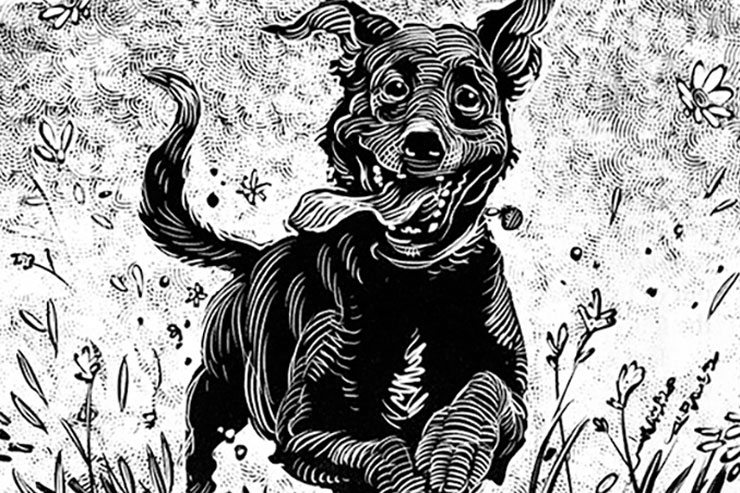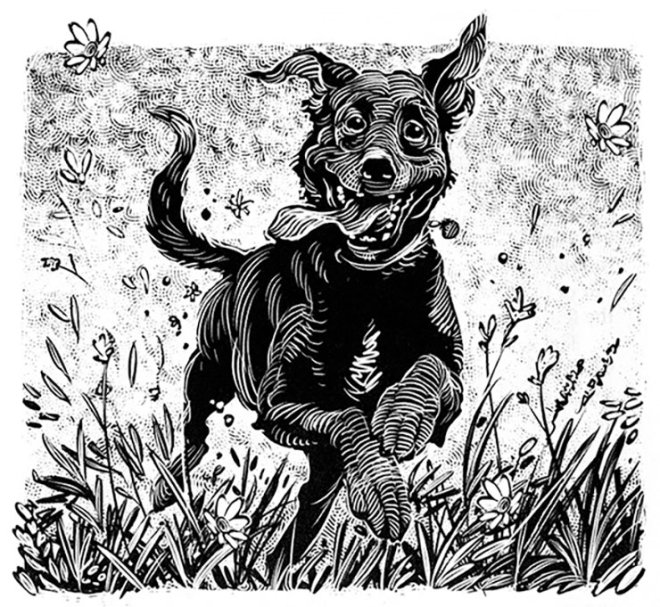
Is there anything cuter than a puppy in the garden, ears flopping as it discovers the wonders of the world, like butterflies and dhalias? Perhaps not. Some pups will even help keep the garden free of critters that would be more than happy to make a party meal of your petunias.
Sometimes, though, dogs and gardens can be at odds, as Bob McCray realizes in Fauna in the Flora. Bob explains that ever since their new puppy arrived, he and his wife have found “flattened irises, mangled peonies, and crushed marigolds. In the middle of it all, our new pup, Grizzly, lay fast asleep in a nest of daisies, with flower petals in her hair.”
While their neighbors had similar problems with animals in the garden, their solution of fencing off the flowers didn’t fit Bob’s fence-free philosophy. What did fit his philosophy was patience. As is so often the case in life, the universe rewarded his patience and attentiveness with answers.
I’ll let Bob tell the whole story, but I think you’ll find the outcome to be a stroke of genius.
Discover 7 top tips for growing, harvesting, and enjoying tomatoes from your home garden—when you access the FREE guide The Best Way to Grow Tomatoes, right now!
Learning life lessons from the animals in the garden
This story comes from our archive that spans over 30 years and includes more than 130 magazine issues of GreenPrints. Pieces like these that inject the joy of gardening into everyday life lessons always brighten up my day, and I hope it does for you as well. Enjoy!

Fauna in the Flora
How we learned a (no-fence) way to keep our dog out of our garden.
By Bob McCray
A while back, I decided I needed one area of my life where I could take a break from technology, one area where I could remain a beginner. As Proust said, “The real voyage of discovery consists not in seeking new landscapes, but in having new eyes.”
I picked gardening, and decided to follow William Wordsworth’s advice and let Mother Nature be my teacher. I gardened without books, TV gardening shows, or the Internet.
Our garden became a real joy in our lives. After a while, the picture window replaced our TV. There was the morning show, when a mother raccoon bathed her three babies in our birdbath. There were the spring and fall wild bird documentaries and the squirrel sitcom: the antics of a teenage squirrel trying to get to our birdfeeder. And there was the evening waddling possum show. For years, we lived at peace in our home garden. But then disaster struck. And it turned out that our own dog—our pet—was our garden nemesis.
I remember when I first saw our trampled garden—the flattened irises, mangled peonies, and crushed marigolds. In the middle of it all, our new pup, Grizzly, lay fast asleep in a nest of daisies, with flower petals in her hair—like Ferdinand the bull in the children’s story.
Luther Burbank’s little dog, Bonita, had free run of his treasured botanical garden. And in Mannheim, Germany, in the 1900s, a dog named Rolf was known for his botanical identifications. However, Grizzly was not so gently inclined.

Our neighbors had similar problems with their two Springer spaniels. They used the old fence-within-a-fence routine. They installed a fence around their property and, inside it, a second, white picket fence around their flower garden. But I am a don’t-fence-me-in kind of guy. I didn’t want a bunch of enclosures.
When flowers in our garden kept getting crushed, I was tempted to break my resolution and search the internet for articles under keywords such as dog sensitivity training, dog manners, dog courtesy, dogs and their hobbies, brown spots, even dogwood! But I stuck to my “learn on our own” resolution, and finally the answer emerged.
My wife and I were relaxing in our lawn chairs one day when we noticed a slight discoloration of the grass in our backyard. There was an unusual yellow streak about six inches wide. It ran from the patio across the yard and through the garden to the alley. It was straight as an arrow.
At first, I thought it might have been caused by the broken wheel on our fertilizer spreader. But on closer look, it appeared to be some kind of trampled path.
We didn’t have long to wait to find out. The wail of a minibike coming down the alley pierced the air like a chainsaw. As the minibike rode by, the back door banged open, and Grizzly blasted out of the house in pursuit. She ran pell-mell down the path to the fence—straight as an arrow.
The minibike stopped at the end of the alley, spun out a wheelie on some gravel, and sped back by. Again, Grizzly tore across the yard to the fence, barking ferociously like a guard dog at a tow company storage lot.
The secret was unlocked before our eyes. We owned a dog that ran on paths!
As the afternoon unfolded, we discovered that Grizzly took three prearranged routes: up the middle of the yard and to the right through the Japanese iris and chrysanthemums; up the middle of the yard and to the left through the bachelor buttons and peonies; and straight up the middle—over the asters.
I headed for the garage, grabbed a spade, and within two hours grafted a two-foot-wide grassy boulevard right in the middle of the garden, transplanting the flowers I’d dug up to safety zones. I grafted grass boulevards on all Grizzly’s paths.
“It looks like the Tuileries Gardens in Paris,” my wife said, smiling. And as if by magic, our yard was peaceful again.
Over the years, we’ve learned a lot from our garden. Dostoyevsky said, “Love all of God’s creation… every grain of sand . .. every leaf … Love the animals, love the plants, love everything. If you love everything, you will soon perceive the divine mystery in things.”
More and more—to slow down and find meaning in our lives—we’ve turned to Mother Nature and her creatures, great and small. ❖
By Bob McCray, published originally in 2015, in GreenPrints Issue #102. Illustrations by Tim Foley.

Did you enjoy this story about animals in the garden? Leave a comment below with your own story!
Discover 7 top tips for growing, harvesting, and enjoying tomatoes from your home garden—when you access the FREE guide The Best Way to Grow Tomatoes, right now!




